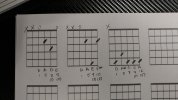snarf
making guitars wish they were still trees
Question for the more theory minded among us. I was playing along to a jam track tonight, and I got a bulb while I was playing.
Looking at the pic below, there are 3 different ways to play a D9 chord. Going from the left, we have kind of the power chord version of D9. The middle is a variation that I think sounds good sometimes as an alternative to the one on the left (I dig the sound of the F# in it). And the one on the right is the D9 that we learn to play in blues.
Here's my question. I can easily see why the left and the middle are called D9. However, tonight I realized that the one on the right has a 7 in it. So is it really like a D7/9 or something or why is it called D9? The theory that I remember tells me that I should add whatever flavoring I'm adding to the chord name (hence asking about it being a D7/9) so a D9 would be 1, 3, 5, 9 or some variation of those 4. Adding a 7 into that would make it...something else. Or does adding the 9 negate the fact that a 7 was added when it comes to naming the chord. Or is it that we play 7s all the time in blues, so the blues version is simply called D9 because the 7 is implied because blues?
Am I on the right track or is it time for me to step away from the crack pipe for the night?

Looking at the pic below, there are 3 different ways to play a D9 chord. Going from the left, we have kind of the power chord version of D9. The middle is a variation that I think sounds good sometimes as an alternative to the one on the left (I dig the sound of the F# in it). And the one on the right is the D9 that we learn to play in blues.
Here's my question. I can easily see why the left and the middle are called D9. However, tonight I realized that the one on the right has a 7 in it. So is it really like a D7/9 or something or why is it called D9? The theory that I remember tells me that I should add whatever flavoring I'm adding to the chord name (hence asking about it being a D7/9) so a D9 would be 1, 3, 5, 9 or some variation of those 4. Adding a 7 into that would make it...something else. Or does adding the 9 negate the fact that a 7 was added when it comes to naming the chord. Or is it that we play 7s all the time in blues, so the blues version is simply called D9 because the 7 is implied because blues?
Am I on the right track or is it time for me to step away from the crack pipe for the night?


